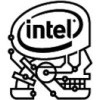- Qualcomm Launches Snapdragon 4 Gen 2 Mobile Platform
- AMD Launches Ryzen PRO 7000 Series Mobile & Desktop Platform
- Intel Launches Sleek Single-Slot Arc Pro A60 Workstation Graphics Card
- NVIDIA Announces Latest Ada Lovelace Additions: GeForce RTX 4060 Ti & RTX 4060
- Maxon Redshift With AMD Radeon GPU Rendering Support Now Available
Intel Skulltrail Enthusiast Platform Preview

Consisting of two Extreme Quad-Core processors, Intel is looking to redefine what we know as “high-end”. Skulltrail is touted as being the “ultimate” enthusiast platform, offering SLI and Crossfire support, huge overclocking abilities and enough sheer power to make the competition weep.
Page 14 – Dual QX9775 vs. QX9770
Because our QX9775 processors are similar to the LGA775 equivalent, the QX9770, I thought it would be interesting to pit the two against each other directly, using specific multi-threaded benchmarks, including a few that Intel recommended for inclusion.
Both processors include a 3.2GHz clock speed, 12MB of L2 cache, a 1600FSB and include SSE4 support. The main differences are the TDP’s, with the QX9770 having one of 136W, while the QX9775 has one of 150W. That difference won’t effect anything performance wise though. Both processors were run with the same 1.3v voltage, just on different motherboards.
First, I ran a variety of multi-threaded benchmarks on each system, to see what differences can be seen. Cinebench was re-run here under Windows Vista 64-Bit (as opposed to Windows XP earlier in the review), TMPGEnc Express, ProShow Gold, Microsoft Excel, 3DMark 2006’s CPU suite and also a DivX encoding.
|
Benchmark
|
2 x QX9775
|
QX9770
|
Increase %
|
| Cinebench 32-Bit Cinebench 64-Bit |
20198 23598 |
12285 14278 |
64.41% 65.27% |
| TMPGEnc Express | 1:14 | 1:24 | 13.51% |
| ProShow Gold | 1:03 | 1:17 | 26.22% |
| Excel Calculations Excel Monte Carlo |
2.671s 9.125s |
4.930s 17.004s |
84.57% 86.34% |
| 3DMark 2006 | 6416 | 4811 | 33.36% |
| VirtualDub/DivX | 4:14 | 4:38 | 9.44% |
It’s evidenced quickly that adding a second CPU does make a difference, but not to the extent you might think. Cinebench, for example, saw a 65% speed increase, despite having 100% more cores available. Remarkably, Excel saw the largest increase. Too bad it lasted all of 2.671 seconds!
Sandra is a synthetic benchmark that can show the potential speed increases of a given processor or benefits of extra cores. The results shown below are not too surprising, with results of close to 100% for each of the Arithmetic and Multi-Media runs. As we saw above though, those differences are rarely seen in real-world tests.
|
SiSoftware Sandra
|
2 x QX9775
|
QX9770
|
Increase %
|
| Memory Bandwidth | 5215 Int 5484 Float |
7756 Int 7760 Float |
-48.72% -41.50% |
| CPU Arithmetic | 117944 MIPS 85419 MFLOPS |
59391 MIPS 42719 MFLOPS |
98.58% 99.95% |
| CPU Multi-Media | 849669 Int it/s 535807 Float it/s |
424337 Int it/s 272432 Float it/s |
100.00% 96.68% |
Memory bandwidth was hit hard, although the loss is unlikely to effect anything but the most memory-intensive workstation applications.
Lastly, to test multi-tasking ability, I ran Nero Recode once by itself, and then again while playing Microsoft’s Flight Simulator X. Nero Recode can use upwards of four cores, while FSX can use two and more throughout our gameplay run.
|
Benchmark
|
2 x QX9775
|
QX9770
|
Increase %
|
| Nero Recode | 10:20 | 10:04 | 2.64% |
| Flight Sim + Nero | 11:22 | 12:40 | 11.44% |
Compared to the single QX9770, our Skulltrail system managed to recode the video 11.44% faster. With a more system intensive game, or another application that utilizes more cores, larger gains would be seen. But the above example is the most realistic scenario.
Support our efforts! With ad revenue at an all-time low for written websites, we're relying more than ever on reader support to help us continue putting so much effort into this type of content. You can support us by becoming a Patron, or by using our Amazon shopping affiliate links listed through our articles. Thanks for your support!





